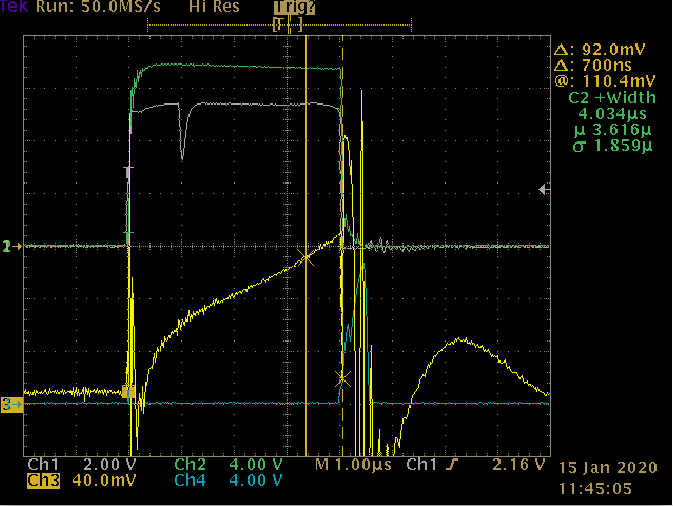I finally got around to testing with the TI TLV1805 comparator. Basically the same circuit but I did rework the PCB for a tighter layout.


The TLV1805's performance was disappointing. It's propagation delays were about the same as the MIC6270 - about 1uS. Aside from a cleaner (square) output due to the push-pull driver, its performance (ratiometric, stability, etc.) was identical to the MIC.
I decided to lower the Vref to 110mV which equates to 3.3uS, so with a 1uS delay I'd get a duty cycle under 4.5uS. I needed to make sure the timing would track linearly to the reference since going much lower becomes a problem for stability in noisy environments. The duty cycle dropped to just under 4.5uS - okay but not much margin if the design dictates a shorter on-time. Below is the timing trace - note the cursors marking Vref and turn-off time.

This outcome forced a reevaluation of the MIC version: I updated Vref to 110mV and repeated the timing tests. It bested the TLV by nearly 400nS for a duty cycle just over 4uS:

CH1=gate drive input, CH2=gate drive output, CH3=current sense input @ comparator, CH4=comparator output. Aside from the TLV's clean output pulse (hard to see), the traces are identical sans the shorter DC of the MIC.
The MIC's output has more slew because of the open-collector output stage and pull-up resistor but it does not effect performance. Given this, the MIC6270 is the obvious choice. The only points against it are the need for a pull-up resistor and temperature qualification to ambients of 85C (vs. 150C for the TLV). Temperature should be okay since thermal management will keep the maximum rise under 30C with a maximum ambient of 40C. So, with a unit costs on Digikey of $0.33 plus a $0.10 resistor I can buy two of these for less than the unit cost of a TLV1805. Sometimes the cheaper part really is the better choice.
While I was wise to test both versions, I could have been smarter and known the TLV1805's performance if I had studied the data sheet more closely - as it applies to this application. In this case it is the combination of hysteresis and overdrive. The TLV has 14mV of hysteresis intentionally built-in to prevent false triggering. Assuming Vref is centered in the hysteresis, 7mV equates 200nS:
Given (V * dt) / L = di
and I * R = V, the current sense voltage increase by
((V * dt) / L) * R,
substituting ((14 * 200e-9) / 8.35e-6) * 0.02) = 6.7mV
Figure 47 shows the propagation times based on the overdrive (the instantaneous difference between the comparator's inputs) with a 12V supply. At 25C it's ~ 800nS. This plus the hysteresis time delay is about 1uS.
Conversely, the MIC6270 does not have the hysteresis feature and its propagation times are solely based on overdrive. A 20mV overdrive will produce a 5V high output in about 500nS which is close to observed performance.
Okay, the MIC it is. Now I can start work on a complete draft of the balancer section and prototyping the SEPIC for the charger.
Discussions
Become a Hackaday.io Member
Create an account to leave a comment. Already have an account? Log In.